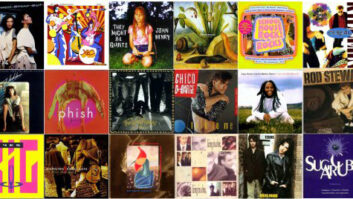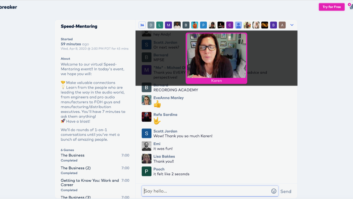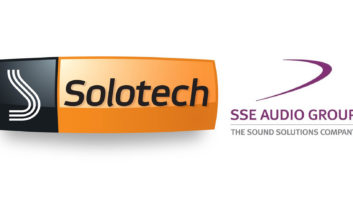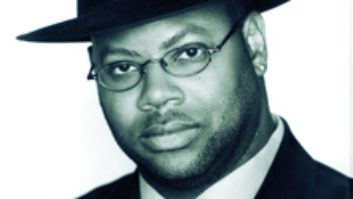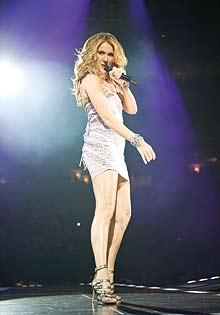
Celine Dion sings through a Sennheiser SKM 5200 with a Sennheiser ME 5005e.
Photos: Steve Jennings
On February 20, Celine Dion packed the HP Pavilion in San Jose, Calif., near the end of her 130-city Taking Chances world tour. As in her last worldwide outing 10 years ago, Dion was in the round, a setup she insists on to bring her closer to her audience. Rolling with 18 trucks and a Meyer Sound P.A. provided by Solotech, Dion’s power-packed vocals filled the arena and brought her legion of fans to their feet several times during the performance. Her front-of-house engineer Francois Desjardins provided an active mix, with both energy and clarity.
As the concert is an “in-the-round” affair, front-of-house engineer Francois Desjardins (left) notes that there are some challenges to mixing for this format: “The most obvious is the dramatic change in the sound quality of the venue between soundcheck and the show. The fact that we energize every section of the arena does not help. During the afternoon, the reverb time is longer, you don’t feel the short echoes as much. At night, the reverb time decreases dramatically and then you hear those disturbing echoes. It decreases the intelligibility considerably.”
However, his mixing style does not change, working under the guideline of following the artist’s emotion during the show. “When she receives a good ‘vibe’ from the crowd,” he explains, “she will be a bit more dynamic and dramatic. I try to respect and transmit this emotion as much as possible. I think I learned that from watching Denis Savage [who was Celine’s FOH mixer for more the 20 years and is now tour director] for more than 15 years [when I was] Celine’s systems engineer.”
He is mixing on a Studer Vista 5 (72 outputs, 36 stereo ins, 12 mono outs, 20 stereo outs and 8 stereo matrix). For dynamic processing, he employs two XTA SIDDs and a Junger b42. The FX rack sees a TC Electronic 6000 and Fireworks, and two Eventide Eclipses.
“For the past 12 months, we did more than 130 shows with the equipment,” he continues. “Everything works as expected from the first night to the last night. I think this is pretty outstanding.”

Front-of-house engineer Francois Desjardins
With any tour that is carrying a full P.A., the geometry and sound quality of the room becomes an important factor. According to Desjardins, when they began designing the system two years ago, they realized that they needed a P.A. that could be easily hung and quickly reconfigured. With the help of Mario St-Onge of Solotech Inc. (the tour’s main system provider), they decided on a Meyer Sound system: four arrays of MILO 18s for the long side of the venue. “We use the MICA in four-array of 18 for the short side of the venue,” he adds. “We preferred the MICA because of its extra coverage and less weight. Also, Mario and I felt the MICA had a nicer tone and control at short distance. In between the arrays of MILO and MICA in each corner, we used six 700-HPs for a total of 24 in the air. If you look carefully, you will notice a total of eight 700-HPs in each corner: This is Mario’s ingenious power, motor and audio signal distribution that resides inside the two first dummy 700-HPs!” Rounding out the system are a DF-4 under each subs array, 18 M’elodies, six UPJ-1Ps as frontfills and 16 more 700-HPs under the stage.
There is a master digital Galileo that receives the two stereo mixes from the FOH Vista 5 and one stereo mix from a backup FOH console. The 16 outputs drive four other Galileos in digital: One manages the MILOs; one the MICAs; the third one handles the sub; and the last one, the frontfills.

Monitor engineer Jean Charles Ethier
Drummer Dominique Messier’s kit is miked with Senn-heiser e 902 (kick, toms), Yamaha Sub-Kick, Shure SM57 (snare), Neumann KM150 (hi-hat) and KM184 (overheads), and a Radial passive DI (drum machine).
Nanette Fortier’s percussion setup is miked with Senn-heiser e 609 (congas), Shure Beta 98 (bongos, timpani, timbales), Neumann KM184 (tambourines, tables), AKG 460+CK5 (overheads) and a Radical Passif (percussion machine).
Jean-Sebastien Carre (guitars on right) and Andre Coutu’s (left) setup includes a Shure SM57 on electric guitar, and Sennheiser SK-5212 transmitter with EM 3732 receiver for violin and acoustic guitar; Carre’s violin also takes the Senn-heiser transmitter and receiver. Keyboardist Yves Frulla has four direct premix outputs from the keyboard rig.
Keyboardist Claude “Mego” Lemay has premix outputs coming from his rig. His electric and acoustic guitars take a Senn-heiser SK-5212 transmitter and EM 3732 receiver; electric guitar is miked with a Shure SM57.
Monitor engineer Jean Charles Ethier (left) is also manning a Studer Vista 5 (24 stereo mixes, 16 FX auxes), using such features as snapshots and the Contributes function to access the mix directly. His rack gear comprises SSL X Logic Series, four TC Electronic 6000s, Millennia preamps and a host of analog gear — no plug-ins to be found. Ethier has 16 reverb channels coming out of the 6000s, using them for the band effects, “as we are using in-ears,” he says, “one on the drum, one on percussions, two for guitar, two for keyboard, one on violin, one on acoustic guitar, one on piano, four for vocal, two guests and one for Celine.”
